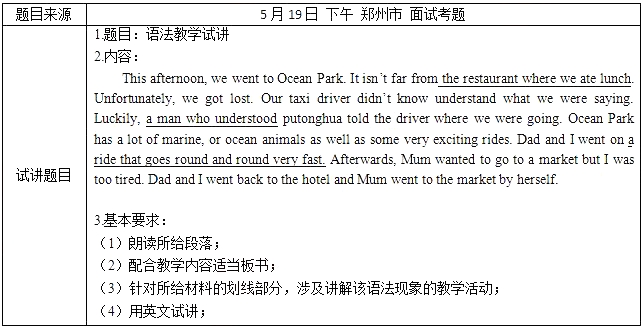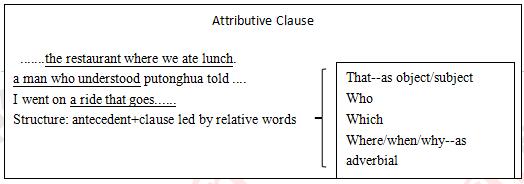ЎЎЎЎіхЦРУўХZЎ¶Attributive ClauseЎ·
ЎЎЎЎТ»Ўўҝјо}»Шоҷ

ЎЎЎЎ¶юЎўҝјо}ҪвОц
ЎЎЎЎЎҫҪМ°ёЎҝ
ЎЎЎЎTeaching Aims:
ЎЎЎЎKnowledge aim: Students will master the structure of attributive Clause and understand what the relative words or antecedents are.
ЎЎЎЎAbility aim: Students can use the attributive clause to describe what happened in their daily life and make up more superior sentences.
ЎЎЎЎEmotional aim: Students will be inspired to study both English and putonghua very well so that they can solve problems they will meet abroad by themselves.
ЎЎЎЎTeaching Key Points:
ЎЎЎЎStudents acquire the clause structure and know the relative words as well as antecedents.
ЎЎЎЎTeaching Difficult Points:
ЎЎЎЎStudents can apply the structure into daily communication and get the difference between relative pronoun and adverb.
ЎЎЎЎTeaching Methods:о}ДҝҒнФҙУЪҝјЙъ»Ш‘ӣ
ЎЎЎЎCommunicative teaching method, task-based teaching method, situational teaching method.
ЎЎЎЎTeaching Aids:
ЎЎЎЎPPT, Blackboard and so on
ЎЎЎЎTeaching Procedures:
ЎЎЎЎStep 1: Warming up
ЎЎЎЎ1.Greetings
ЎЎЎЎ2.Review: Show students two sentences. One is an adverbial clause of place that linked by where and the other is an attributive clause that also linked by where Where there is a will there is a way. Let them find out the differences or similarities between them and lead to what weЎҜre going to learn today.
ЎЎЎЎStep 2: Presentation
ЎЎЎЎ1. Read the passage briefly and and answer 3 questions. Where is the Ocean park? Who helped us? How was the ride? To lead the three underlined parts Then write down the three sentences students choose from the passage after reading.
ЎЎЎЎ2.Explain the common parts of these three sentences and show the structure of attributive clause.
ЎЎЎЎ3.Tell students that when the antecedent is a person or an object, we should choose different relative words. Also, they should understand the difference between attributive clause linked by where and the adverbial clause of place linked by where.о}ДҝҒнФҙУЪҝјЙъ»Ш‘ӣ
ЎЎЎЎStep 3: Practice
ЎЎЎЎ1. Give them some sentences with blankets and let them choose the proper relative words.
ЎЎЎЎ2. Show them several clauses and find out which are attributive clauses.
ЎЎЎЎStep 4: Production
ЎЎЎЎDiscussion and share: students work in pairs to describe their travel by using attributive clauses; teacher will give them 5 minutes to prepare it and 5 minutes later, invite some students to share their experiences.
ЎЎЎЎStep 5: Summary & Homework
ЎЎЎЎSummary : students look at the blackboard and summarize this class.
ЎЎЎЎHomework:students find more rules about attributive clauses and prepare for the next class.
ЎЎЎЎBlackboard design:

ЙПТ»ЖӘЈә2018ЙП°лДкёЯЦРУўХZҪМҺҹЩYёсЧCГжФҮХжо}ј°ҙр°ёЈЁөЪ¶юЕъЈ©
ПВТ»ЖӘЈә2018ЙП°лДкРЎҢW(xuЁҰ)УўХZҪМҺҹЩYёсЧCГжФҮХжо}ј°ҙр°ёЈЁөЪ¶юЕъЈ©
ИЛБҰЩYФҙҝјФҮҪМҺҹЩYёсҝјФҮіц°жҢЈҳI(yЁЁ)ЩYёсҪЎҝө№ЬАнҺҹҢ§(dЁЈo)УОҝјФҮЙз•ю№ӨЧчХЯЛҫ·ЁҝјФҮВҡ·QУӢЛгҷC IрB(yЁЈng)ҺҹРДАнЧЙФғҺҹУэӢлҺҹКВҳI(yЁЁ)ҶОО»ҪМҺҹХРЖё№«„Х(wЁҙ)ҶT№«ЯxҝјФҮХРҫҜҝјФҮЯxХ{(diЁӨo)Йъҙе№Щ
іхјү•юУӢВҡ·QЦРјү•юУӢВҡ·QҪӣ(jЁ©ng)қъҺҹЧўғФ•юУӢҺҹЧCИҜҸДҳI(yЁЁ)гyРРҸДҳI(yЁЁ)•юУӢҢҚІЩҪy(tЁҜng)УӢҺҹҢҸУӢҺҹёЯјү•юУӢҺҹ»щҪрҸДҳI(yЁЁ)ЩYёс¶җ„Х(wЁҙ)ҺҹЩY®a(chЁЈn)Фu№АҺҹҮшлHғИ(nЁЁi)ҢҸҺҹACCA/CATғrёсиbЧCҺҹҪy(tЁҜng)УӢЩYёсҸДҳI(yЁЁ)
Т»јүҪЁФмҺҹ¶юјүҪЁФмҺҹПы·А№ӨіМҺҹФмғr№ӨіМҺҹНБҪЁВҡ·Q№«В·ҷzңy№ӨіМҺҹҪЁЦю°ЛҙуҶTЧўғФҪЁЦюҺҹ¶юјүФмғrҺҹұO(jiЁЎn)Ан№ӨіМҺҹЧЙФғ№ӨіМҺҹ·ҝөШ®a(chЁЈn)№АғrҺҹ іЗаl(xiЁЎng)ТҺ(guЁ©)„қҺҹҪY(jiЁҰ)ҳӢ(gЁ°u)№ӨіМҺҹҺrНБ№ӨіМҺҹ°ІИ«№ӨіМҺҹФO(shЁЁ)ӮдұO(jiЁЎn)АнҺҹӯh(huЁўn)ҫіУ°н‘ФuғrНБөШөЗУӣҙъАн№«В·ФмғrҺҹ№«В·ұO(jiЁЎn)АнҺҹ»Ҝ№Ө№ӨіМҺҹЕҜНЁ№ӨіМҺҹҪoЕЕЛ®№ӨіМҺҹУӢБҝ№ӨіМҺҹ
ҲМ(zhЁӘ)ҳI(yЁЁ)ЛҺҺҹҲМ(zhЁӘ)ҳI(yЁЁ)бt(yЁ©)ҺҹРl(wЁЁi)ЙъЩYёсҝјФҮРl(wЁЁi)ЙъёЯјүВҡ·QЧoКҝЩYёсЧCіхјүЧoҺҹЦч№ЬЧoҺҹЧЎФәбt(yЁ©)ҺҹЕRҙІҲМ(zhЁӘ)ҳI(yЁЁ)бt(yЁ©)ҺҹЕRҙІЦъАнбt(yЁ©)ҺҹЦРбt(yЁ©)ҲМ(zhЁӘ)ҳI(yЁЁ)бt(yЁ©)ҺҹЦРбt(yЁ©)ЦъАнбt(yЁ©)ҺҹЦРОчбt(yЁ©)бt(yЁ©)ҺҹЦРОчбt(yЁ©)ЦъАнҝЪЗ»ҲМ(zhЁӘ)ҳI(yЁЁ)бt(yЁ©)ҺҹҝЪЗ»ЦъАнбt(yЁ©)Һҹ№«№ІРl(wЁЁi)Йъбt(yЁ©)Һҹ№«Рl(wЁЁi)ЦъАнбt(yЁ©)ҺҹҢҚЫ`јјДЬғИ(nЁЁi)ҝЖЦчЦОбt(yЁ©)ҺҹНвҝЖЦчЦОбt(yЁ©)ҺҹЦРбt(yЁ©)ғИ(nЁЁi)ҝЖЦчЦОғәҝЖЦчЦОбt(yЁ©)ҺҹӢD®a(chЁЈn)ҝЖбt(yЁ©)ҺҹОчЛҺКҝ/ҺҹЦРЛҺКҝ/ҺҹЕRҙІҷzтһјјҺҹЕRҙІбt(yЁ©)ҢW(xuЁҰ)АнХ“ЦРбt(yЁ©)АнХ“